A Numerical Method for Applying Cohesive Stress on Fracture Process Zone in Concrete Using Nonlinear Spring Element
Abstract
:1. Introduction
2. Methods and Materials
2.1. Nonlinear Spring Element
2.2. Methods of Simulation
- According to the test of geometric parameters and material parameters, a finite element model is established and meshed. The crack tip grid element should be performed to meet a singularity of −1/2.
- Apply displacement constraints to the finite element model, and calculate the stress intensity at the crack tip. When it reaches the initial fracture toughness, the crack starts to propagate.
- Crack spreads forward for a certain unit length Δa, and the finite element model is re-established and remeshed. Add the spring element between the newly generated interface.
- Use the displacement results from the previous step as the initial displacement conditions for this step.
- Determine whether the crack propagation criterion is satisfied. If not, increase the loading point displacement until the criterion is satisfied.
- Repeat steps 4 to 5 until the crack tip extends to the edge of the model, and the simulation of the entire crack propagation process ends. The calculation flow diagram is shown in Figure 7.
2.3. Materials for Simulation
3. Results and Discussion
3.1. P-Delta Curve
3.2. P-CMOD Curve
3.3. FPZ Length
3.4. Curve
4. Conclusions
- The P-delta curves obtained from numerical simulation were used to recalculate fracture energy and compared with the input value. The direct application of cohesion produced results that were much smaller than the true value, while the proposed method of applying cohesion by the spring element can improve the accuracy of the applied cohesion.
- Using the proposed method to apply the cohesive stress on the FPZ for numerical calculation, though the peak load obtained is larger than the no-iteration result, P-CMOD curves obtained are still fitted the experimental results, indicating that the cohesion is applied in a reasonable manner, and the crack propagation criterion based on material initial fracture toughness is suitable for numerical simulation.
- The FPZ length obtained by the iteration method can reach a larger maximum value compared with no-iteration, and the decline gradient of the FPZ length also becomes larger after the FPZ is fully developed. The fracture energy, tensile strength, and geometry shape of the beam are main reasons for deciding the FPZ length. According to the bilinear softening constitutive, fracture energy and tensile strength determine the critical crack opening displacement. A larger critical crack opening displacement or a longer ligament makes it easier to obtain a larger FPZ length.
- The curve obtained with iteration is significantly different from the noniterative curve. The value is continually rising with the crack propagation. After the FPZ length has fully developed, the rising rate of the curve has become slow. Through the synergistic comparison with the change of the FPZ length, it is proved that the value is mainly affected by the fracture energy and FPZ length. The iterative method is more suitable for simulating the curves by improving the accuracy of the cohesion on the FPZ.
Funding
Data Availability Statement
Conflicts of Interest
References
- Hoover, C.G.; Bažant, Z.P.; Vorel, J.; Wendner, R.; Hubler, M.H. Comprehensive concrete fracture tests: Description and results. Eng. Fract. Mech. 2013, 114, 92–103. [Google Scholar] [CrossRef]
- De Domenico, D.; Urso, S.; Borsellino, C.; Spinella, N.; Recupero, A. Bond behavior and ultimate capacity of notched concrete beams with externally-bonded FRP and PBO-FRCM systems under different environmental conditions. Constr. Build. Mater. 2020, 265, 121208. [Google Scholar] [CrossRef]
- Erdogan, F.; Sih, G.C. On crack extension in plates under plane loading and transverse shear. J. Basic Eng. AMSE 1963, 85, 519–527. [Google Scholar] [CrossRef]
- Palianiswamy, K.; Knauss, W.G. Propagation of crack under general in plane tension. Int. J. Fract. 1972, 8, 114–117. [Google Scholar] [CrossRef]
- Xu, S.L.; Reinhardt, H.W. Determination of double-K criterion for crack propagation in quasi-brittle fracture Part I: Experimental investigation of crack propagation. Int. J. Fract. 1999, 98, 111–149. [Google Scholar] [CrossRef]
- Xu, S.L.; Reinhardt, H.W. Determination of double-K criterion for crack propagation in quasi-brittle fracture Part II: Analytical evaluating and practical measuring methods for three-point bending notched beams. Int. J. Fract. 1999, 98, 151–177. [Google Scholar] [CrossRef]
- Barenblatt, G.I. On the equilibrium cracks forming during brittle fracture. Stability of isolated cracks. Connection with energy theories. Prikl. Mat. Mekh. 1959, 23, 893–900. [Google Scholar]
- Barenblatt, G.I. The mathematical theory of equilibrium cracks in brittle fracture. Adv. Appl. Mech. 1962, 7, 55–129. [Google Scholar]
- Dugdale, D.S. Yielding of steel sheets containing slits. J. Mech. Phys. Solids 1960, 8, 100–104. [Google Scholar] [CrossRef]
- Hillerborg, A.; Modeer, M.; Petersson, P.E. Analysis of crack formation and crack growth in concrete by means of fracture mechanics and finite elements. Cem. Concr. Res. 1976, 6, 773–781. [Google Scholar] [CrossRef]
- Petersson, P.E. Crack Growth and Development of Fracture Zones in Plain Concrete and Similar Materials; Technical Report TVBM-1006; Division of Building Materials, Lund Institute of Technology: Lund, Sweden, 1981. [Google Scholar]
- Reinhardt, H.W.; Cornelissen, H.A.W.; Hordijk, D.A. Tensile tests and failure analysis of concrete. J. Struct. Eng. ASCE 1986, 112, 2462–2477. [Google Scholar] [CrossRef]
- Gálvez, J.C.; Cervenka, J.; Cendon, D.A.; Saouma, V. A discrete crack approach to normal/shear cracking of concrete. Cem. Concr. Res. 2002, 32, 1567–1585. [Google Scholar] [CrossRef]
- Li, Q.; Zhang, F.; Zhang, W.; Yang, L. Fracture and tension properties of roller compacted concrete cores in uniaxial tension. J. Mater. Civ. Eng. 2002, 14, 366–373. [Google Scholar] [CrossRef]
- Gerstle, W.H.; Xie, M. FEM modeling of fictitious crack propagation in concrete. J. Eng. Mech. 1992, 118, 416–434. [Google Scholar] [CrossRef]
- Carpinteri, A.; Massabó, R. Reversal in failure scaling transition of fibrous composites. J. Eng. Mech. ASCE 1997, 123, 107–114. [Google Scholar] [CrossRef]
- Ooi, E.; Yang, Z. A hybrid finite element-scaled boundary finite element method for crack propagation modelling. Comput. Methods Appl. Mech. Eng. 2010, 199, 1178–1192. [Google Scholar] [CrossRef]
- Ooi, E.; Yang, Z. Modelling multiple cohesive crack propagation using a finite element–scaled boundary finite element coupled method. Eng. Anal. Bound. Elem. 2009, 33, 915–929. [Google Scholar] [CrossRef]
- Yang, Z.; Deeks, A. Fully-automatic modelling of cohesive crack growth using a finite element–scaled boundary finite element coupled method. Eng. Fract. Mech. 2007, 74, 2547–2573. [Google Scholar] [CrossRef]
- Moës, N.; Belytschko, T. Extended finite element method for cohesive crack growth. Eng. Fract. Mech. 2002, 69, 813–833. [Google Scholar] [CrossRef] [Green Version]
- Dong, W.; Wu, Z.; Zhou, X. Calculating crack extension resistance of concrete based on a new crack propagation criterion. Constr. Build. Mater. 2013, 38, 879–889. [Google Scholar] [CrossRef] [Green Version]
- Dong, W.; Zhou, X.; Wu, Z. On fracture process zone and crack extension resistance of concrete based on initial fracture toughness. Constr. Build. Mater. 2013, 49, 352–363. [Google Scholar] [CrossRef]
- Wu, Z.; Rong, H.; Zheng, J.; Dong, W. A Numerical Method for Mixed I-II Crack Propagation in Concrete. J. Eng. Mech. ASCE 2013, 139, 1530–1538. [Google Scholar] [CrossRef]
- Dong, W.; Wu, Z.; Zhou, X.; Wang, C. A comparative study on two stress intensity factor-based criteria for prediction of mode-I crack propagation in concrete. Eng. Fract. Mech. 2016, 158, 39–58. [Google Scholar] [CrossRef]
- Dong, W.; Wu, Z.; Tang, X.; Zhou, X. A comparative study on stress intensity factor-based criteria for the prediction of mixed mode I-II crack propagation in concrete. Eng. Fract. Mech. 2018, 197, 217–235. [Google Scholar] [CrossRef] [Green Version]
- Dong, W.; Yang, D.; Zhou, X.; Kastiukas, G.; Zhang, B. Experimental and numerical investigations on fracture process zone of rock–concrete interface. Fatigue Fract. Eng. Mater. Struct. 2016, 40, 820–835. [Google Scholar] [CrossRef] [Green Version]
- Ingraffea, A.R.; Gerstle, W.H. Non-Linear Fracture Models for Discrete Crack Propagation. In Application of Fracture Mechanics to Cementitious Composites; Springer: Dordrecht, The Netherlands, 1985; pp. 247–285. [Google Scholar]
- Ingraffea, A.R.; Gerstle, W.H.; Gergely, P.; Saouma, V. Fracture mechanics of bond in reinforced concrete. Comput.-Aided Des. 1984, 16, 339. [Google Scholar] [CrossRef]
- Ingraffea, A.R.; Saouma, V. Numerical modeling of discrete crack propagation in reinforced and plain concrete. In Fracture Mechanics of Concrete: Structural Application and Numerical Calculation; Springer: Dordrecht, The Netherlands, 1985; pp. 171–225. [Google Scholar]
- Swenson, D.V.; Ingraffea, A.R. Modeling mixed-mode dynamic crack propagation using finite elements: Theory and applications. Comput. Mech. 1988, 3, 381–397. [Google Scholar] [CrossRef]
- Bocca, P.; Carpinteri, A.; Valente, S. Mixed mode fracture of concrete. Int. J. Solids Struct. 1991, 27, 1139–1153. [Google Scholar] [CrossRef]
- Bathe, K.J. Finite Element Procedures; Prentice-Hall: Englewood Cliffs, NJ, USA, 1996. [Google Scholar]
- Wang, C.; Dong, W.; Wang, Q.; Wu, Z.; Qu, X. A Comparative Study on Propagation Criterion of Concrete Mode I Crack. Eng. Mech. 2016, 33, 89–95. (In Chinese) [Google Scholar]
- Tada, H.; Paris, P.C.; Irwin, G.R. The Stress Analysis of Cracks Handbook; ASME: New York, NY, USA, 2000. [Google Scholar]
- Foote RM, L.; Mai, Y.W.; Cotterell, B. Crack growth resistance curves in strain-softening materials. J. Mech. Phys. Solids 1986, 34, 593–607. [Google Scholar] [CrossRef]
- Hu, X.; Wittmann, F.H. An analytical method to determine the bridging stress transferred within the fracture process zone: I, General Theory. Cem. Concr. Res. 1991, 21, 1118–1128. [Google Scholar] [CrossRef]
- Xu, S.; Reinhardt, H.W. Crack extension resistance and fracture properties of quasi-brittle softening materials like concrete based on the complete process of fracture. Int. J. Fract. 1998, 92, 71. [Google Scholar] [CrossRef]
- Lutz, H.E.; Swain, M.V. Interrelation among flaw resistance, KR-curve behavior and thermal shock strength degradation in ceramics. I. Theoretical considerations. J. Eur. Ceram. Soc. 1991, 8, 355–363. [Google Scholar] [CrossRef]
- Lutz, H.E.; Swain, M.V. Interrelation among flaw resistance, KR-curve behavior and thermal shock strength degradation in ceramics. II. Experiment. J. Eur. Ceram. Soc. 1991, 8, 365–374. [Google Scholar] [CrossRef]
- Xu, F.; Wu, Z.; Zheng, J.; Zhao, Y.; Liu, K. Crack extension resistance curve of concrete considering variation of FPZ length. J. Mater. Civ. Eng. 2010, 23, 703–710. [Google Scholar] [CrossRef]

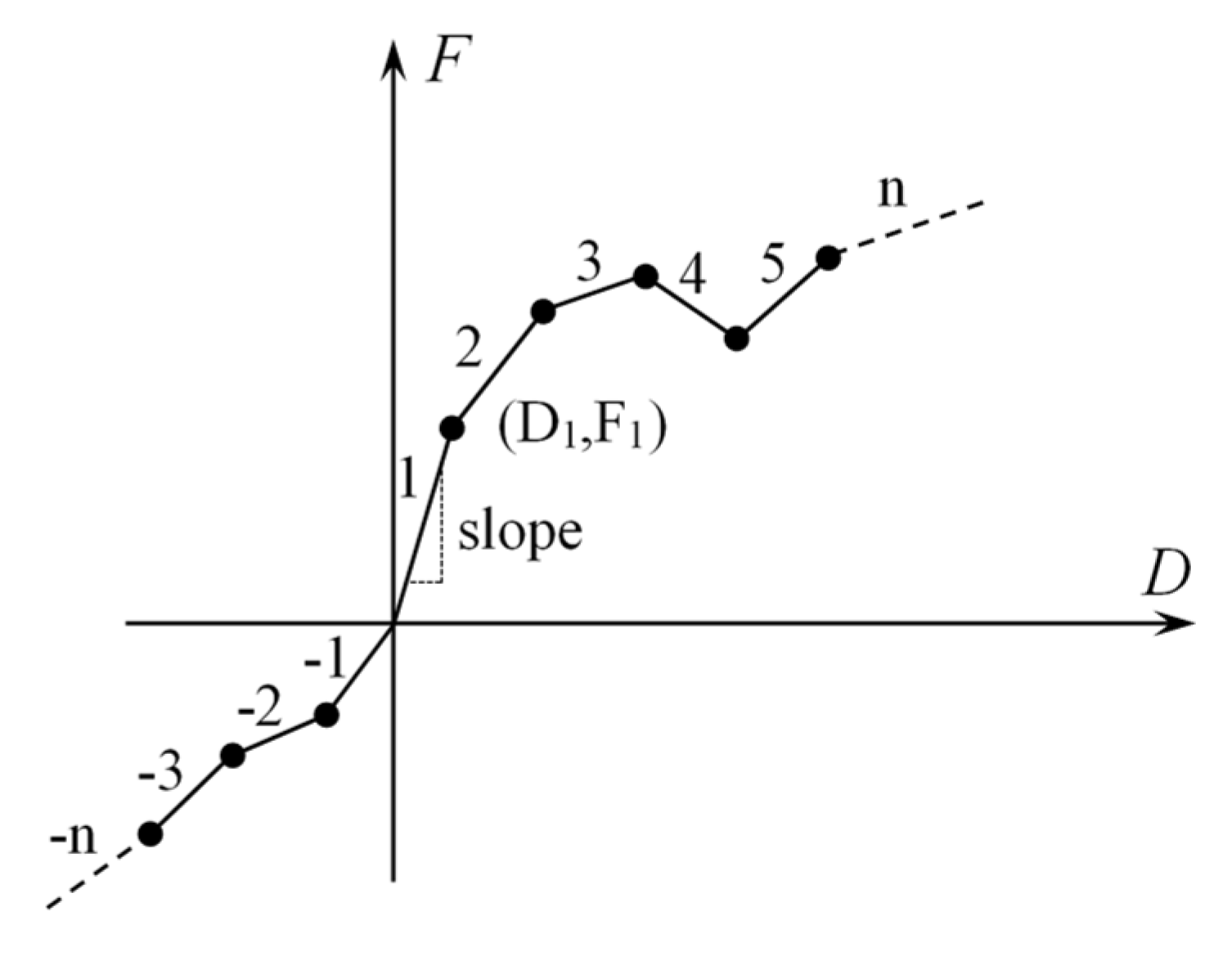
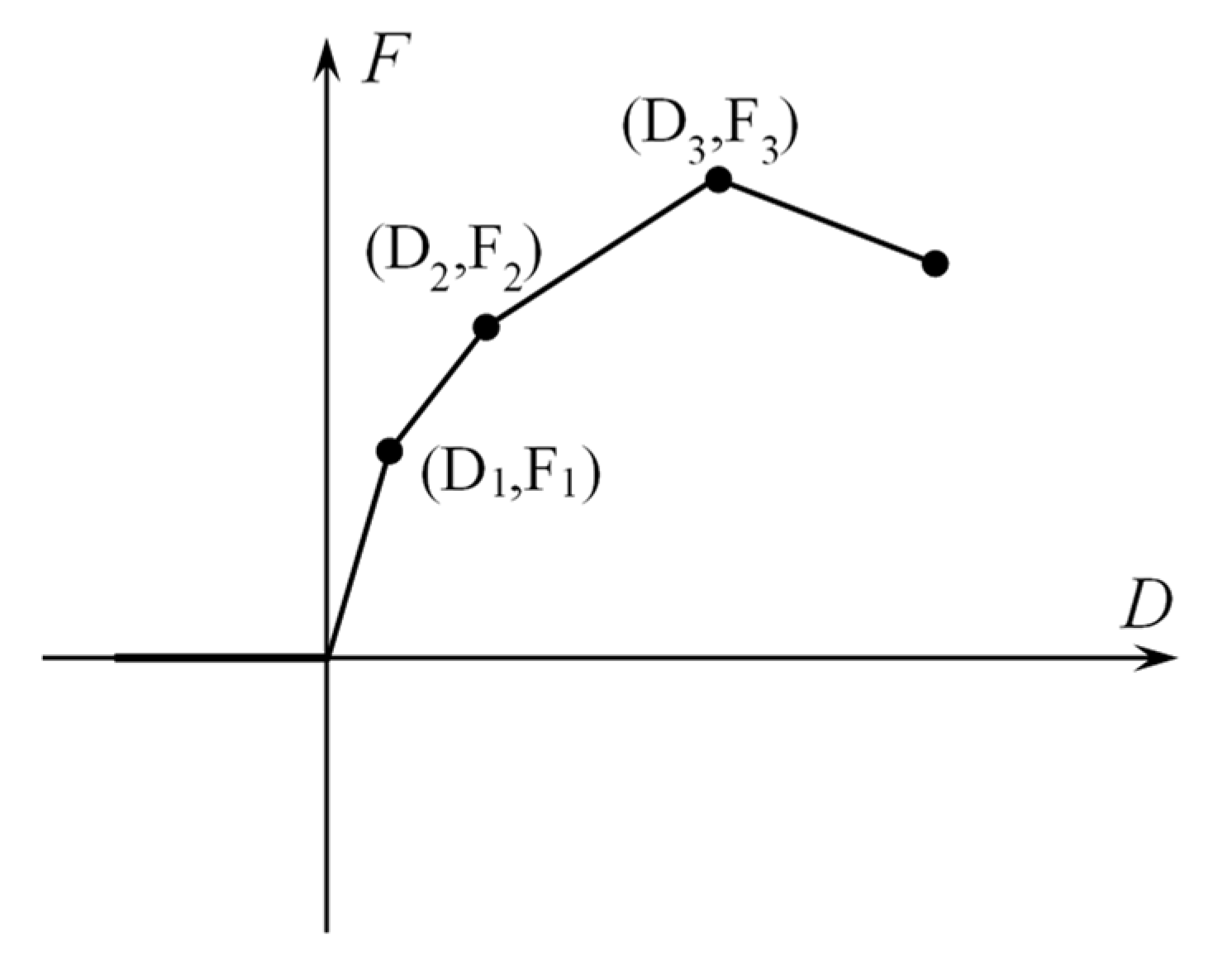
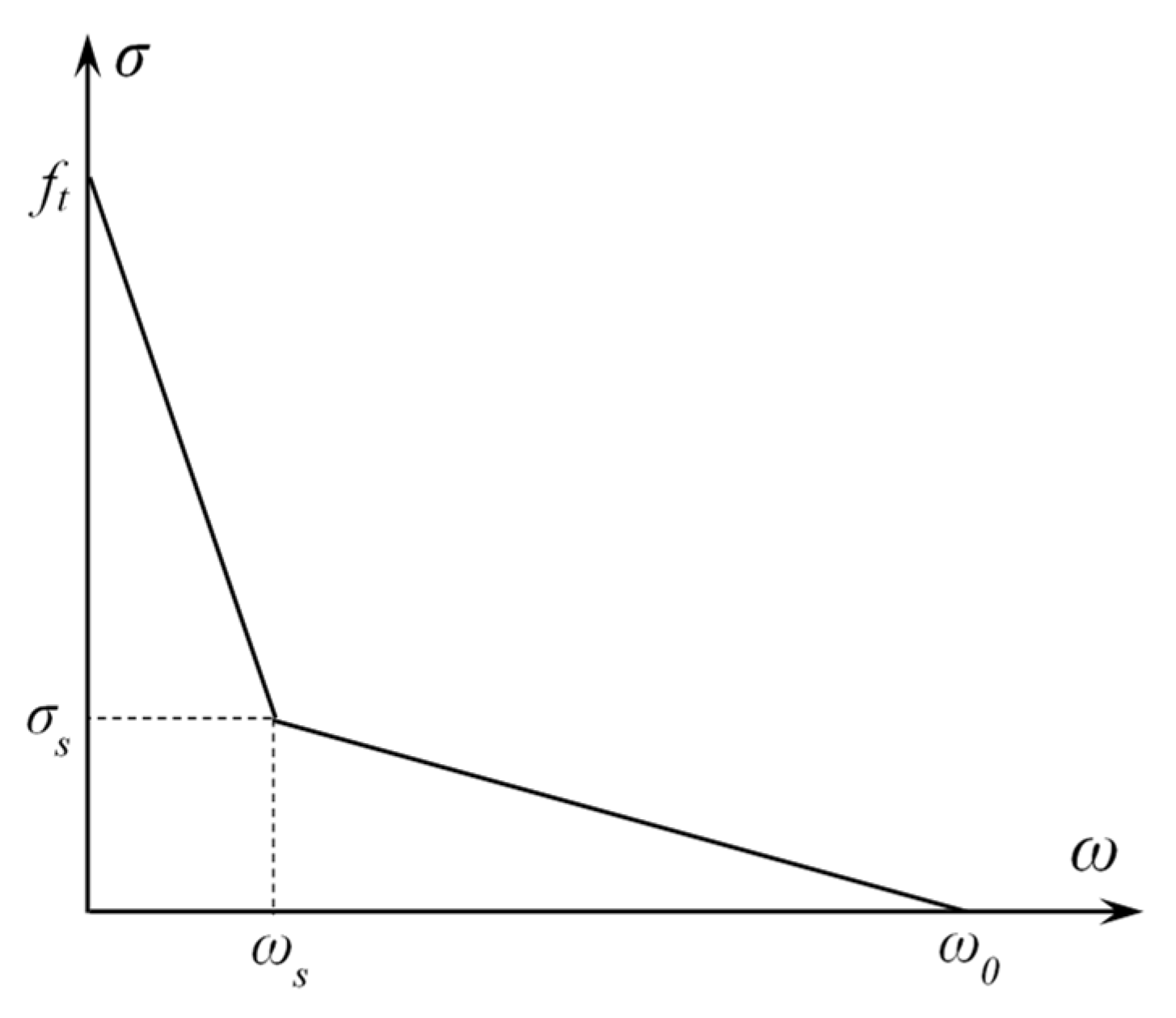

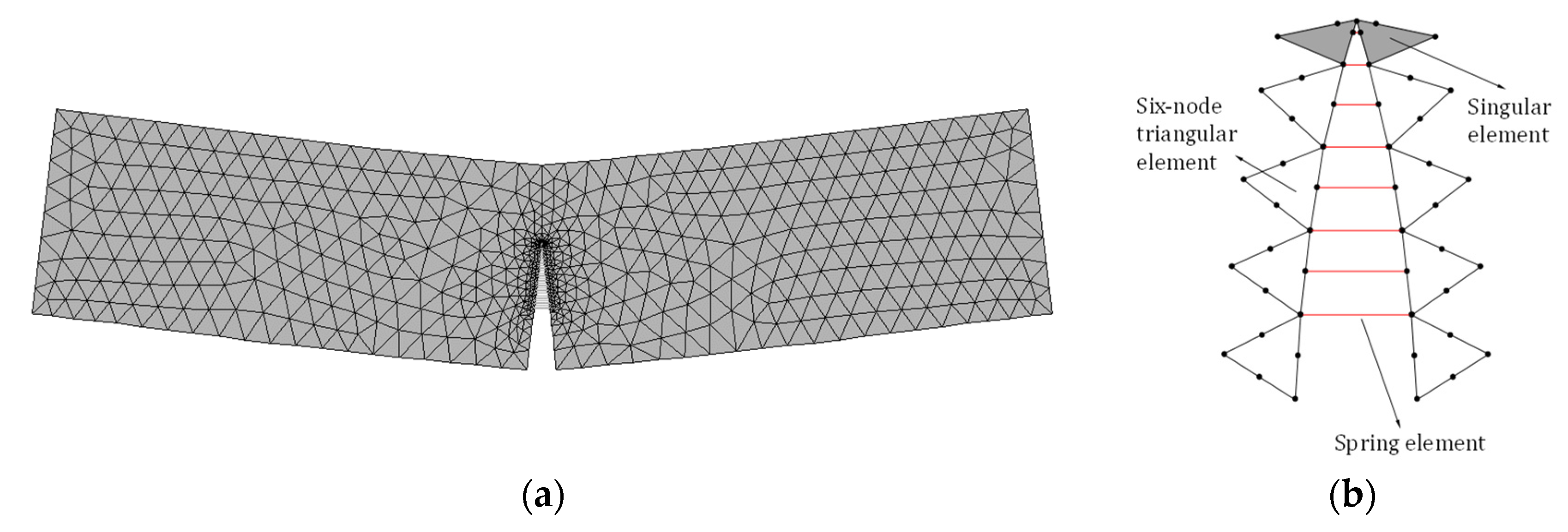
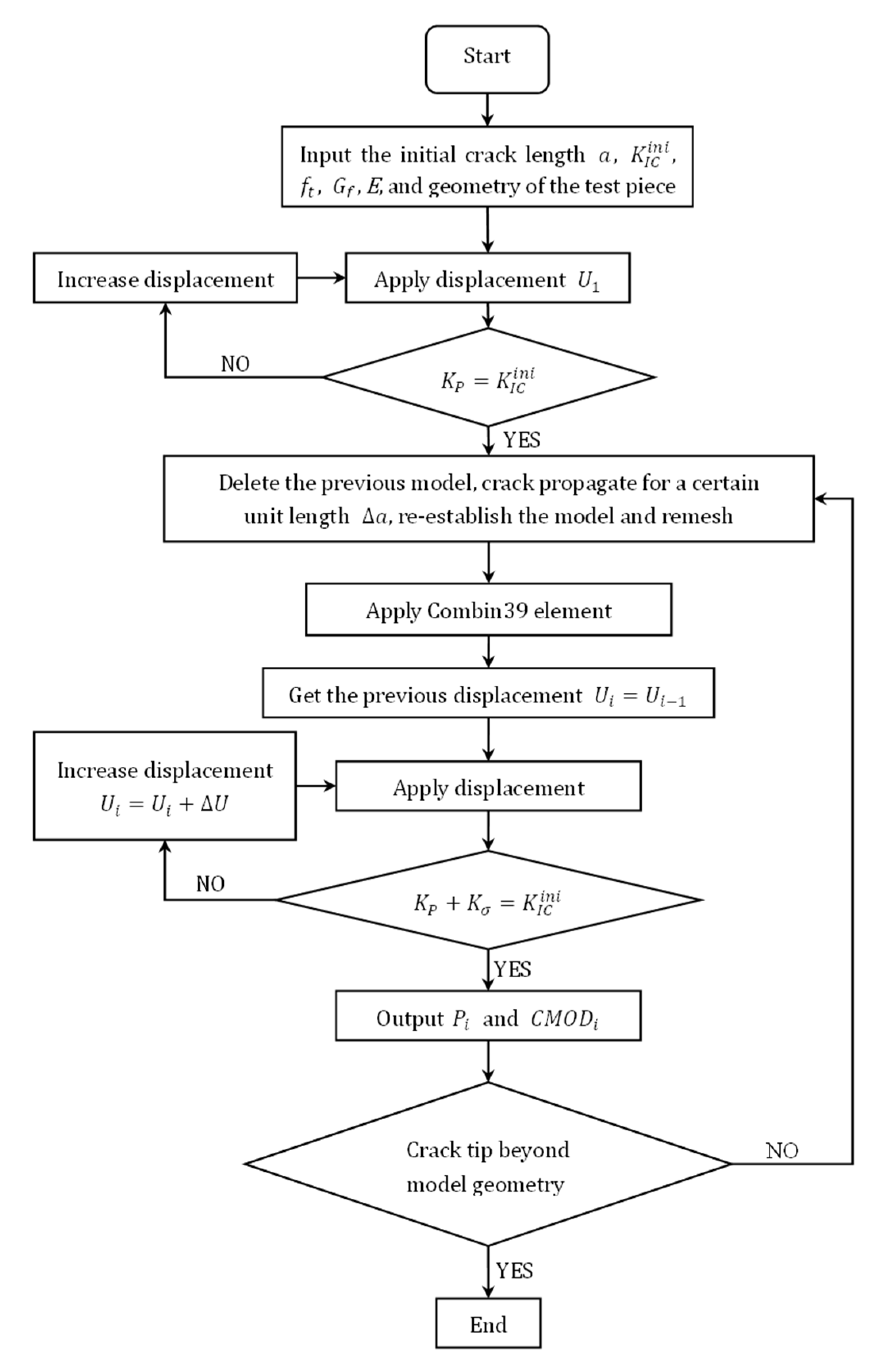

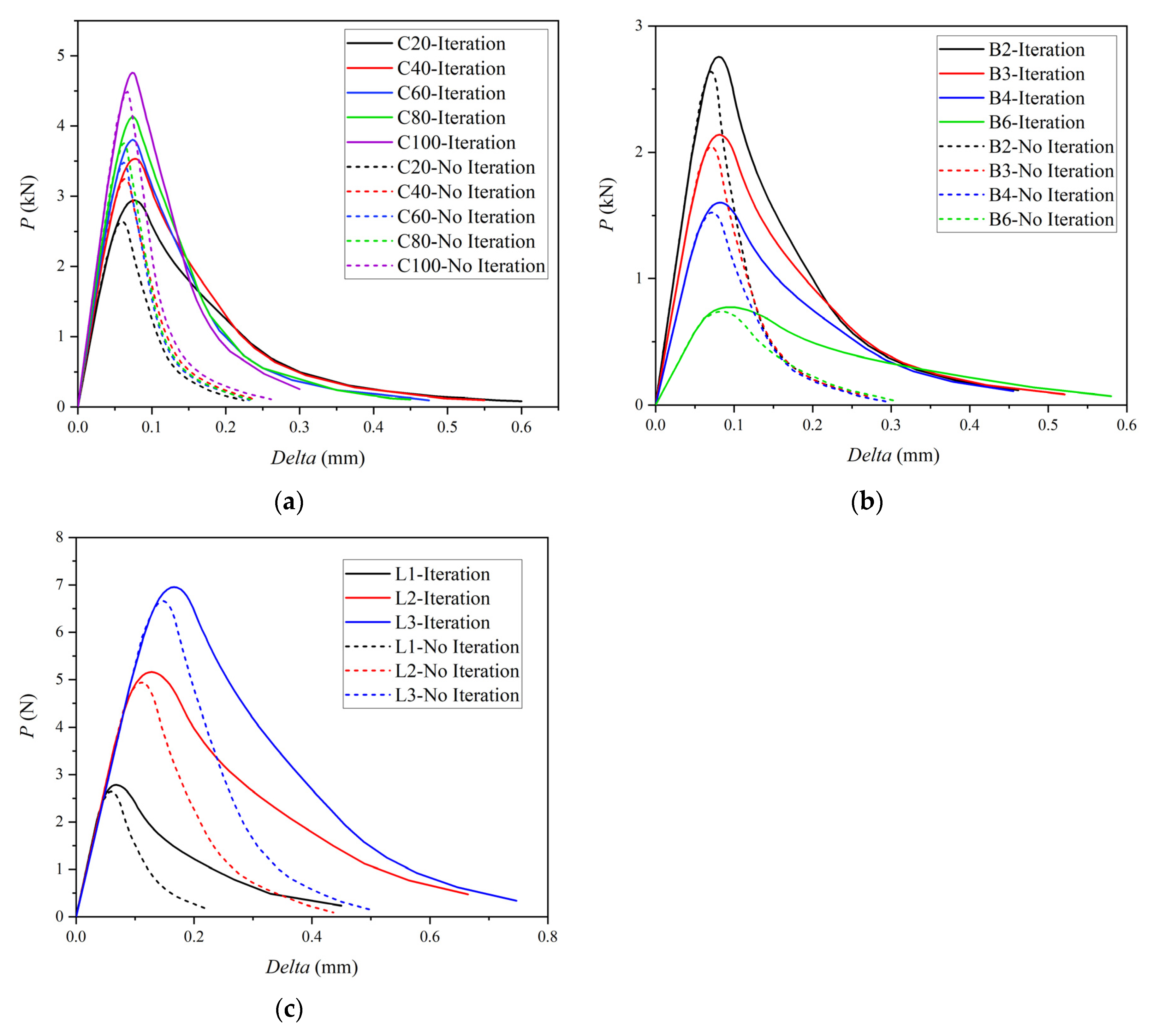
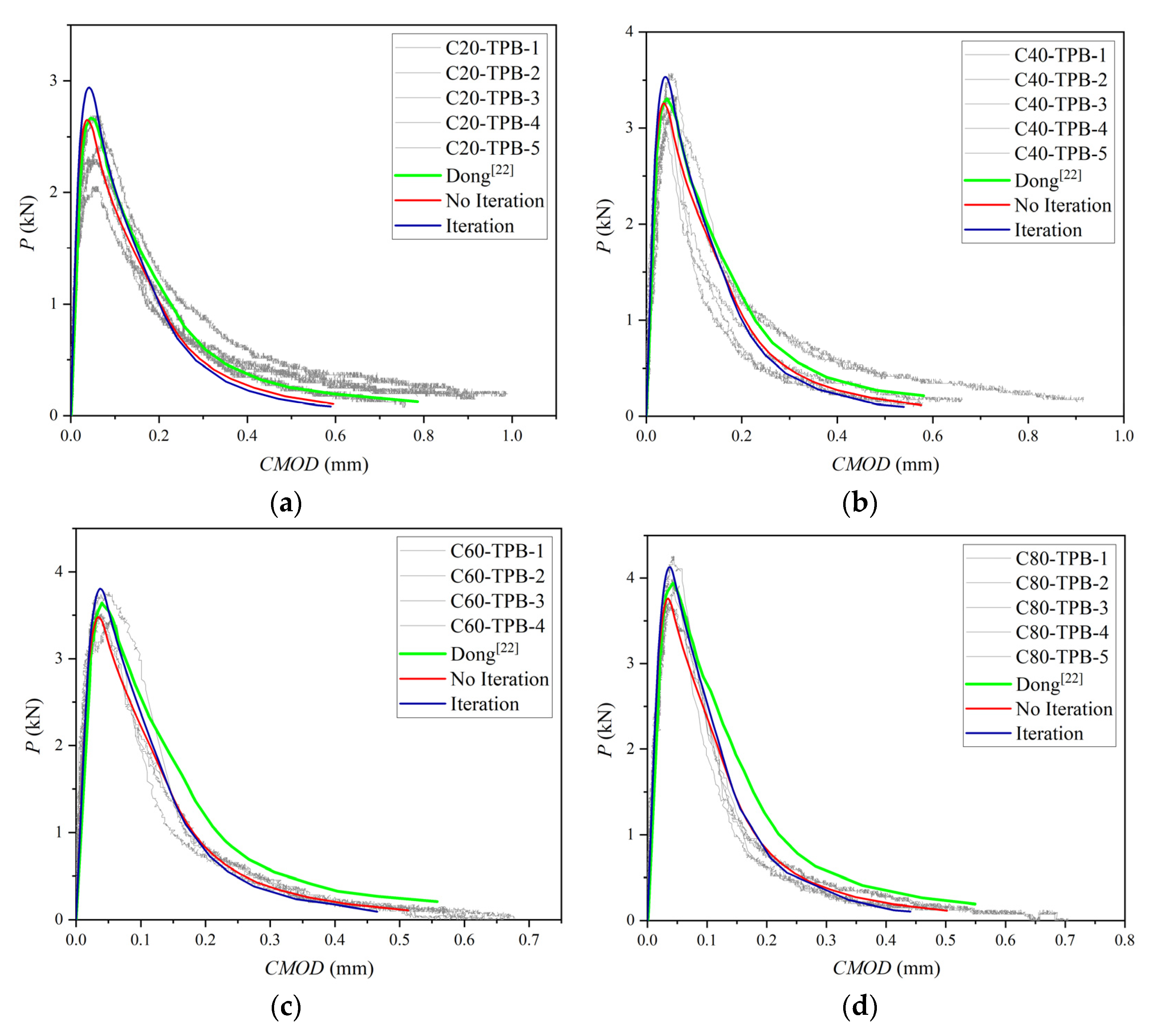
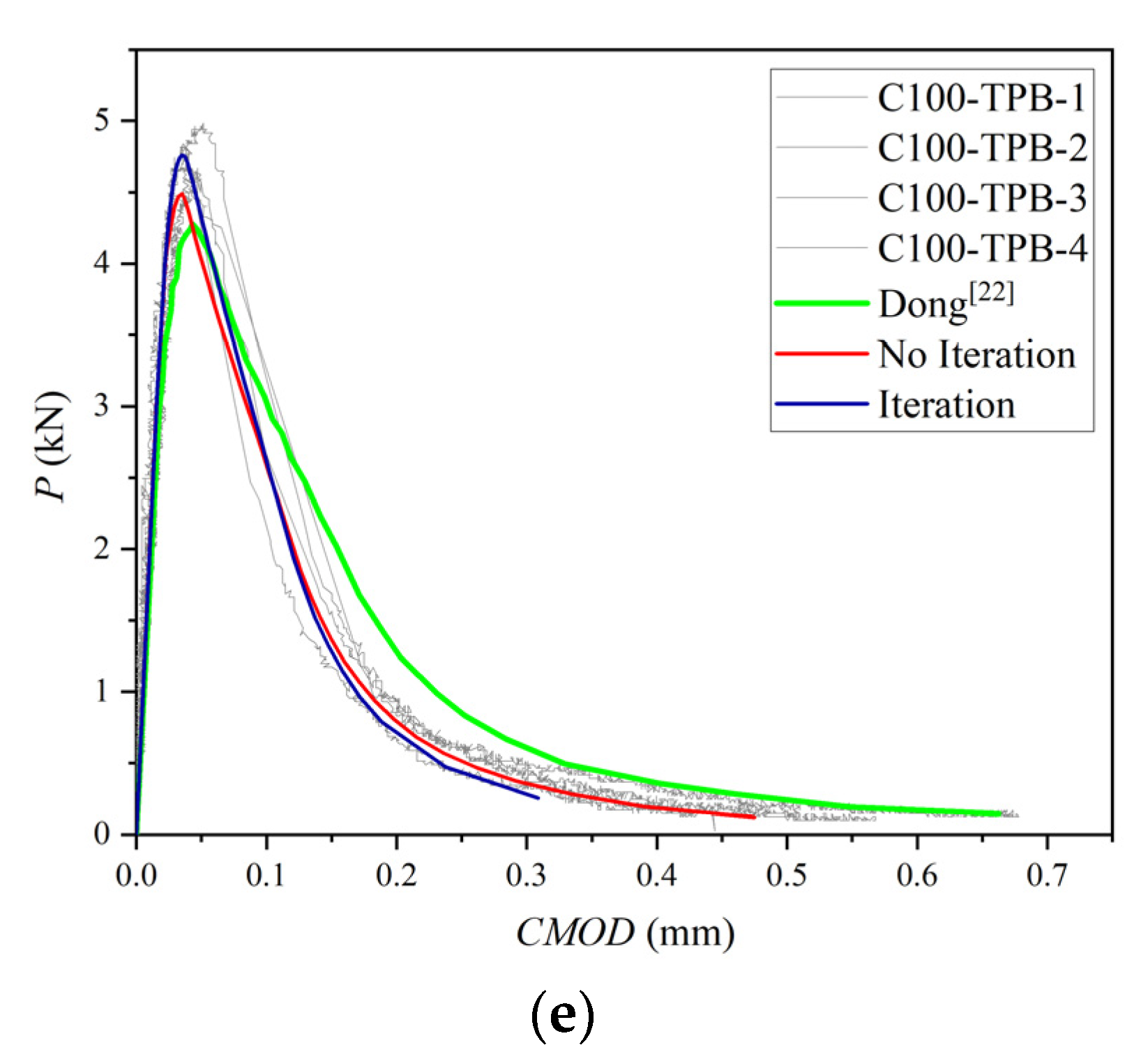

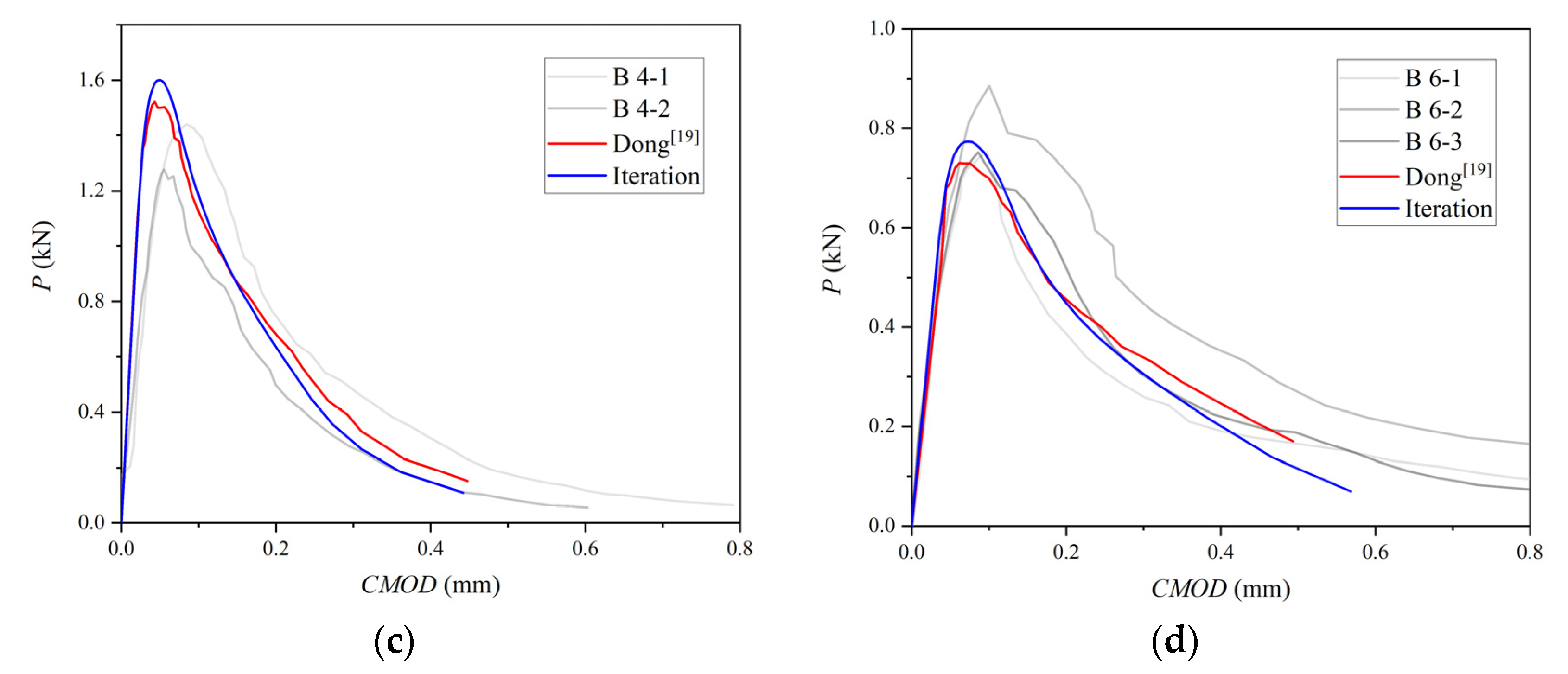
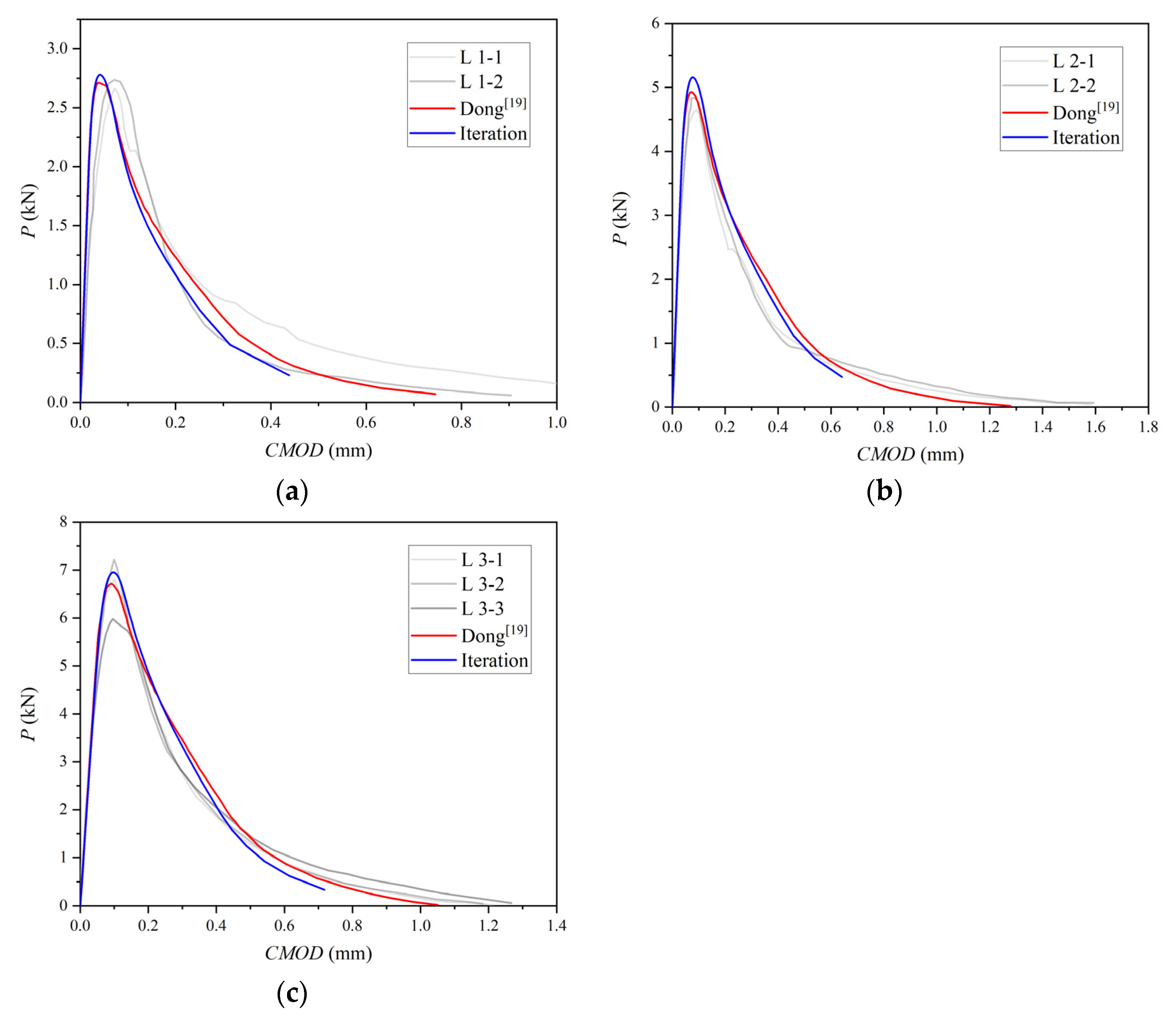


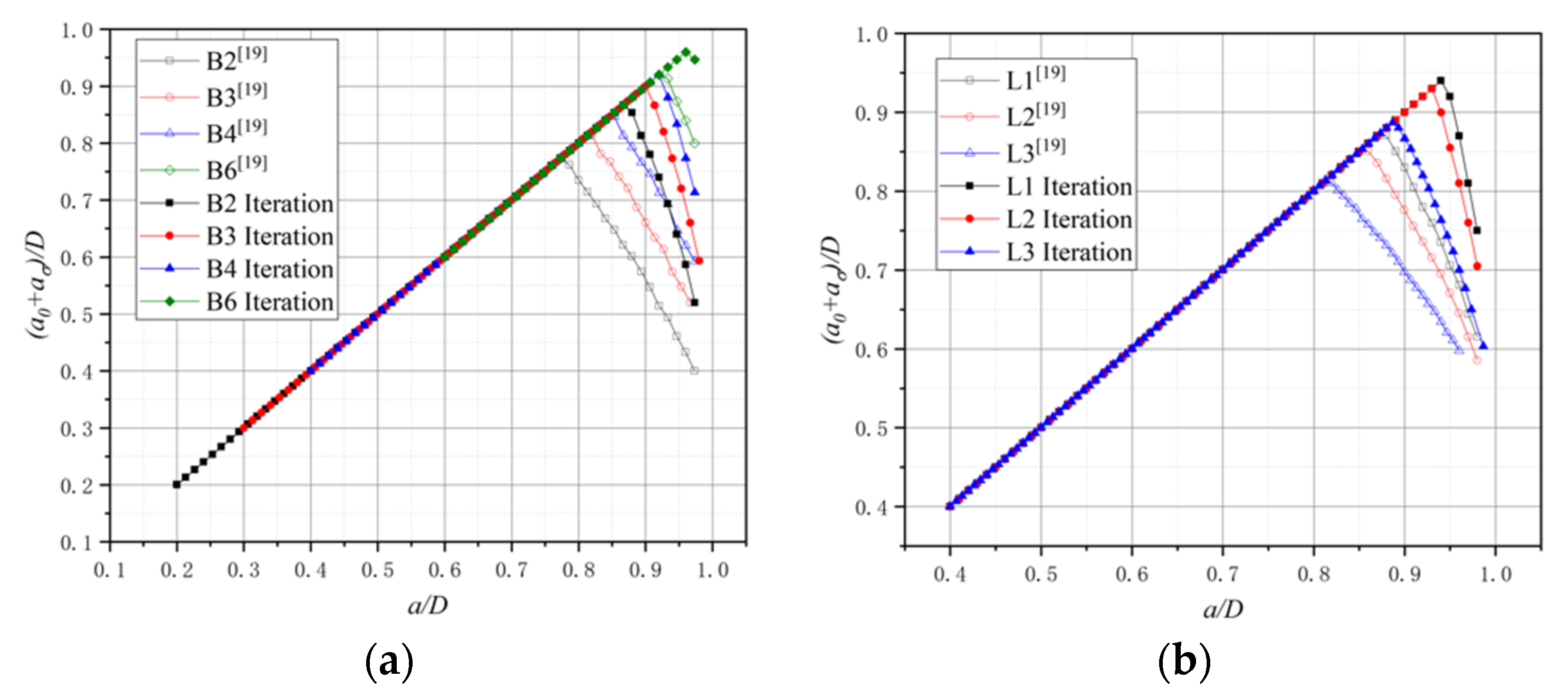
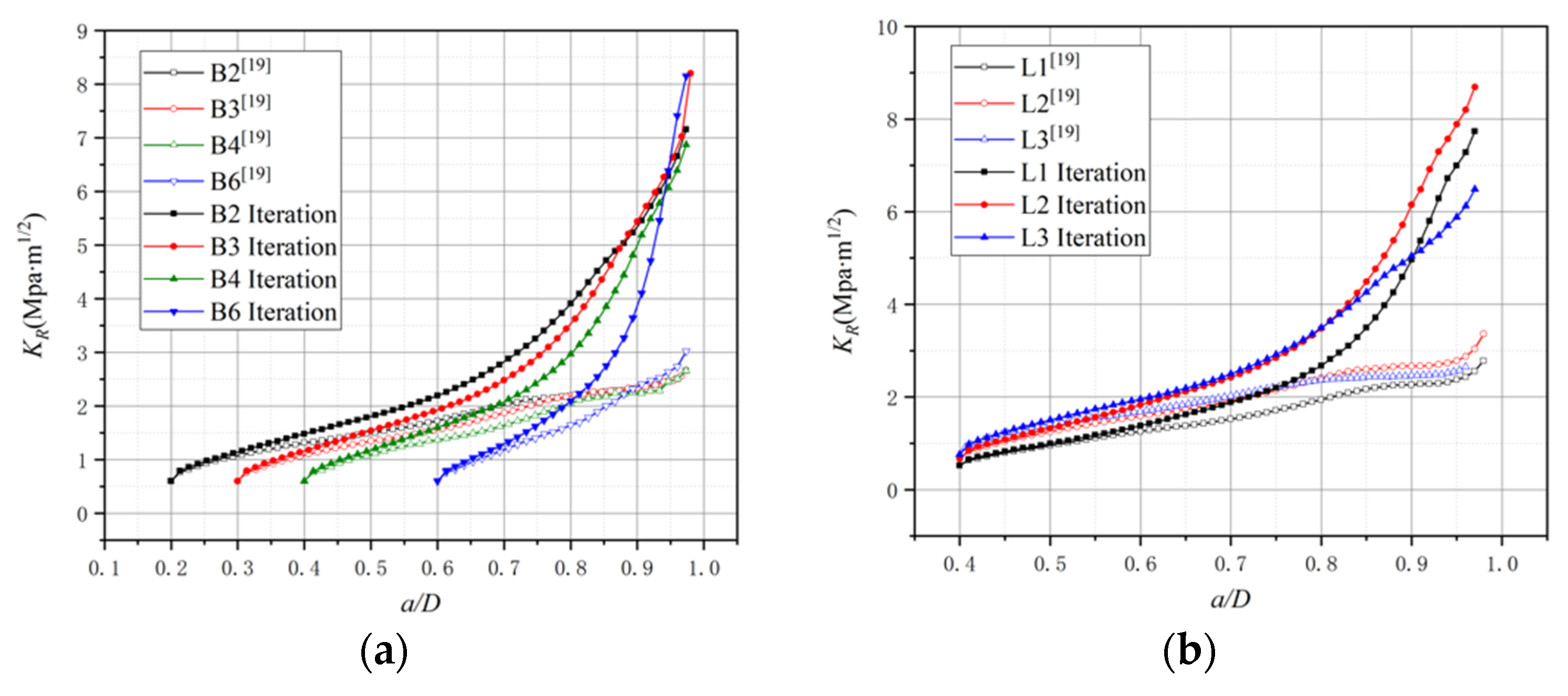

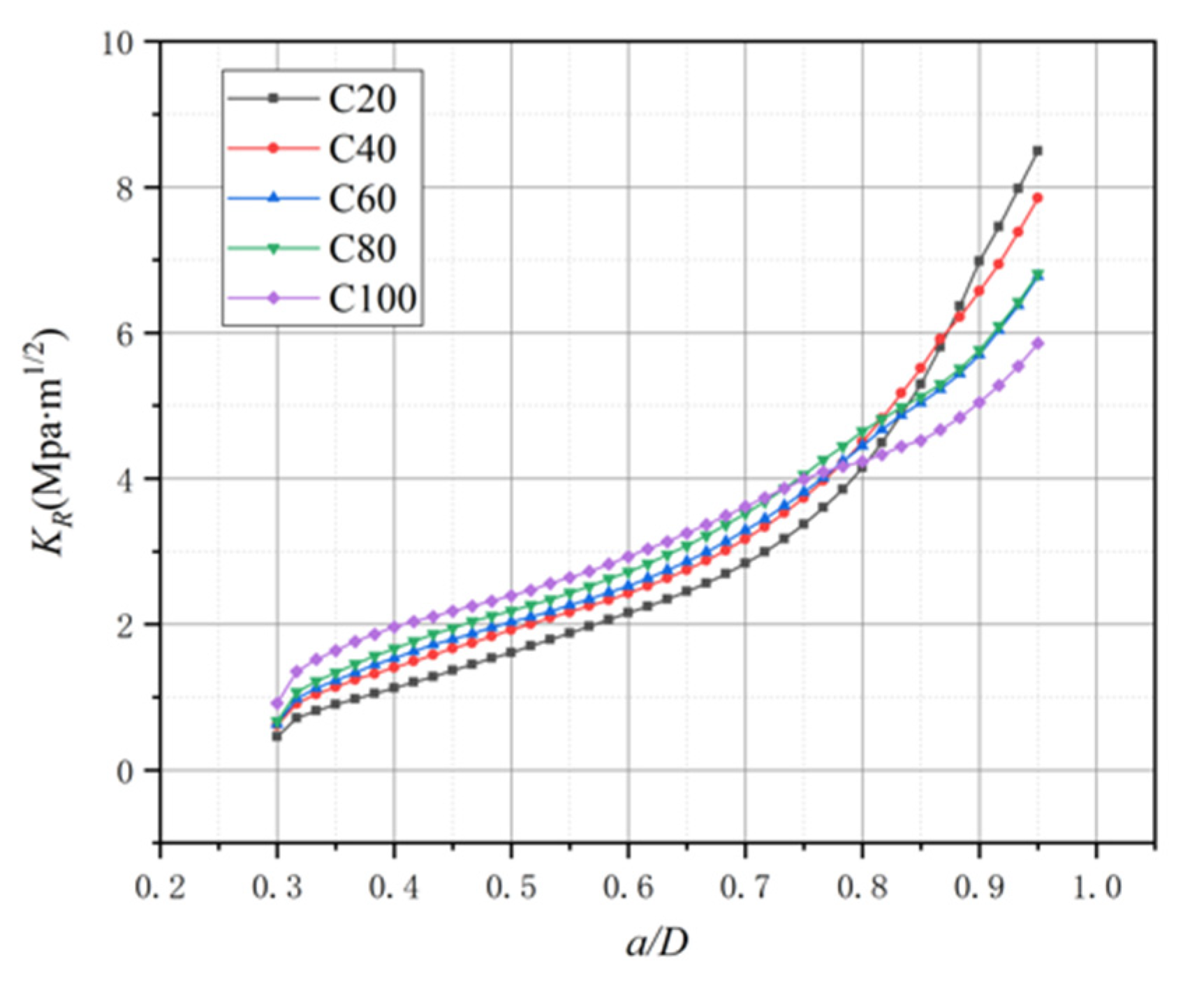
| Concrete | |||||
|---|---|---|---|---|---|
| C20 | 32.8 | 3.05 | 29.9 | 0.461 | 117.1 |
| C40 | 48.9 | 3.74 | 33.2 | 0.616 | 124.5 |
| C60 | 69.9 | 4.43 | 35.7 | 0.632 | 114.9 |
| C80 | 84.1 | 5.01 | 38.1 | 0.667 | 120.5 |
| C100 | 115.8 | 5.71 | 41.4 | 0.917 | 115.4 |
| Specimen | ||||
|---|---|---|---|---|
| B2-1 | 0.2 | 0.60 | 96 | |
| B2-2 | 0.59 | 100 | ||
| B2-3 | 0.62 | 92 | ||
| Avg. | 0.60 | 96 | ||
| B3-1 | 0.3 | 0.65 | 100 | |
| B3-2 | 0.63 | 105 | ||
| B3-3 | 0.53 | 88 | ||
| Avg. | 0.60 | 98 | ||
| B4-2 | 0.4 | 0.58 | 85 | |
| B4-3 | 0.61 | 100 | ||
| Avg. | 0.60 | 92.5 | ||
| B6-1 | 0.6 | 0.60 | 105 | |
| B6-2 | 0.62 | 120 | ||
| B6-3 | 0.58 | 100 | ||
| Avg. | 0.60 | 108 |
| Specimen | ||||
|---|---|---|---|---|
| L1-1 | 0.4 | 0.52 | 104 | |
| L1-2 | 0.52 | 90 | ||
| Avg. | 0.52 | 97 | ||
| L2-1 | 0.4 | 0.71 | 155 | |
| L2-2 | 0.62 | 151 | ||
| Avg. | 0.67 | 153 | ||
| L3-1 | 0.4 | 0.78 | 123 | |
| L3-2 | 0.75 | 146 | ||
| L3-3 | 0.75 | 153 | ||
| Avg. | 0.76 | 141 |
| Group | % | ||||||
|---|---|---|---|---|---|---|---|
| C20-Iteration | 81.37 | 0.60 | 538.5 | 116.5 | 117.1 | −0.5% | |
| C20-No Iteration | 0.22 | 224.2 | 48.0 | −59.0% | |||
| C40-Iteration | 81.37 | 0.55 | 592.5 | 126.4 | 124.5 | 1.5% | |
| C40-No Iteration | 0.24 | 286.0 | 60.6 | −51.3% | |||
| C60-Iteration | 81.37 | 0.48 | 553.0 | 117.5 | 114.9 | 2.2% | |
| C60-No Iteration | 0.23 | 283.5 | 60.0 | −47.8% | |||
| C80-Iteration | 81.37 | 0.45 | 581.3 | 122.6 | 120.5 | 1.7% | |
| C80-No Iteration | 0.23 | 303.0 | 63.8 | −47.0% | |||
| C100-Iteration | 81.37 | 0.30 | 571.6 | 118.3 | 115.4 | 2.5% | |
| C100-No Iteration | 0.26 | 374.4 | 78.5 | −32.0% | |||
| B2-Iteration | 84.76 | 0.46 | 438.2 | 99.5 | 96.0 | 3.6% | |
| B2-No Iteration | 0.26 | 235.8 | 53.7 | −44.0% | |||
| B3-Iteration | 84.76 | 0.52 | 385.9 | 102.4 | 98.0 | 4.5% | |
| B3-No Iteration | 0.27 | 203.2 | 53.8 | −45.1% | |||
| B4-Iteration | 84.76 | 0.46 | 300.2 | 94.1 | 92.5 | 1.8% | |
| B4-No Iteration | 0.29 | 164.3 | 52.5 | −43.3% | |||
| B6-Iteration | 84.76 | 0.48 | 207.1 | 106.8 | 108.0 | −1.1% | |
| B6-No Iteration | 0.30 | 104.9 | 54.3 | −49.7% | |||
| L1-Iteration | 94.18 | 0.45 | 523.0 | 94.2 | 97.0 | −2.9% | |
| L1-No Iteration | 0.22 | 256.7 | 46.2 | −52.3% | |||
| L2-Iteration | 376.7 | 0.66 | 1555.2 | 150.3 | 153.0 | −1.8% | |
| L2-No Iteration | 0.44 | 831.3 | 82.1 | −45.7% | |||
| L3-Iteration | 847.6 | 0.75 | 2178.4 | 156.2 | 141.0 | 10.8% | |
| L3-No Iteration | 0.50 | 1308.6 | 96.2 | −31.7% |
Publisher’s Note: MDPI stays neutral with regard to jurisdictional claims in published maps and institutional affiliations. |
© 2022 by the author. Licensee MDPI, Basel, Switzerland. This article is an open access article distributed under the terms and conditions of the Creative Commons Attribution (CC BY) license (https://creativecommons.org/licenses/by/4.0/).
Share and Cite
Li, Z. A Numerical Method for Applying Cohesive Stress on Fracture Process Zone in Concrete Using Nonlinear Spring Element. Materials 2022, 15, 1251. https://doi.org/10.3390/ma15031251
Li Z. A Numerical Method for Applying Cohesive Stress on Fracture Process Zone in Concrete Using Nonlinear Spring Element. Materials. 2022; 15(3):1251. https://doi.org/10.3390/ma15031251
Chicago/Turabian StyleLi, Zhuheng. 2022. "A Numerical Method for Applying Cohesive Stress on Fracture Process Zone in Concrete Using Nonlinear Spring Element" Materials 15, no. 3: 1251. https://doi.org/10.3390/ma15031251





